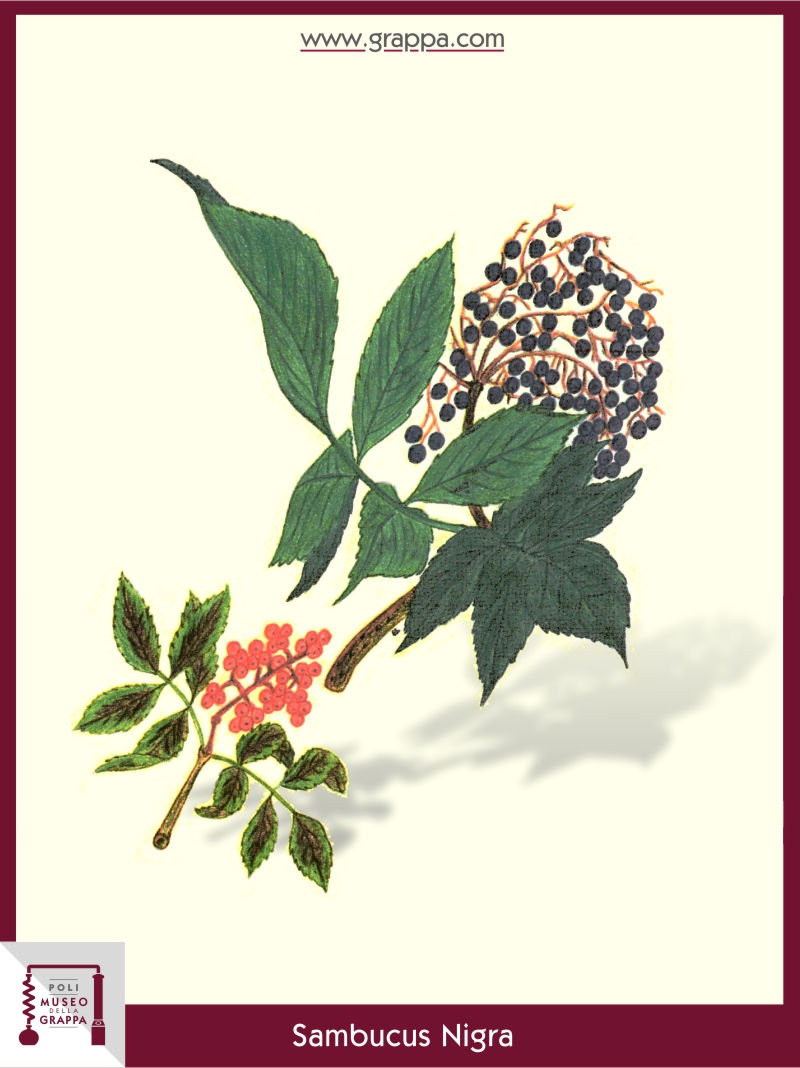Wine, sparkling wine and Grappa of elderberry
- Plant: Elder, Elderberry (Sambucus Nigra)
- Plant part: berry
- Plant feauters: diuretic, antireumatiche, relieving flatulence, purifying, laxative, refreshing, diaphoretic, stimulating for milk , purgative, emollient, sweat-reducing, antineuralgic, pectoral

-
Description:
It seems that the elderberry was widely known by the Greek population which, according to Pliny, used the wood of the plant without the mark to build a flute-like musical instrument called "Sambyké".
The healing powers of the elderberry, according to Galen, Pliny, and also the Arabian physicians capable to heal nervous diseases and headaches, were also able to stimulate the blood flow (including those of the nose) and to alleviate all burn injuries.The most commonly effect attributed to the elderberry is the sweat-reducing of the flowers, the slightly antineuralgic and the soft laxative effect of the fruits.
The last property is strongly used in the folk traditions, where always an extract from strong laxative elderberry was prepared, known as Roob; Such use is also recommended by Albertus Magnus in his famous work "De Virtutibus Herbarum".
The recipe
-
Ingredients:
Homemade sparkling wine:
- 7 liters of water
- 1 glass of white wine
- 1 sliced lemon
- 16 grape elderflower blossoms
- 750 g of sugarGrappa:
- 2 handful of ripe berries of elderberry
- 1 liter of Grappa -
Preparation:
The plant has, however, also many domestic purposes: one of those is the so-called homemade sparkling wine. For the prepration you have to pour 7 liters of water and a glass of white wine into an enamel bowl, as well as a sliced lemon, 16 grapes of elderberry and 750 g of sugar. The mixture is stired occasionally, after one day it is bottled as sparkling wine and after an aging of one month it can be consumed.
A preparation that was "suggested" by Castore Durante more than three centuries ago: "... put the dried elderberry blossoms in a bag and place them in a drum when the must is boiling. Each evening squeeze the bag slightly, so that the wine takes the aroma and taste of the muscat. "The berries serve not only for the production of rustic "wine" (resulting from a weak alcoholic fermentation of the sugars) but also for flavoring of Grappa.
There are two elderberry varieties, often used for grappa: the black and the red.
The black elderberry gives the grappa an intense black-violet color and first a sweet and then a bitter taste. The red elderberry, more rarely represented, typical of the mountain region, gives Grappa a pink color and a vague aroma of nougat with almonds.For both Grappas you need two handful ripe berries, which are put into a liter of Grappa for about three months. During the first three weeks of "maceration" the Grappa must be stored in the sun and mixed frequently. After three months it can be filtered and has to mature for other four months.
Poli Distillerie and
Poli Grappa Museum
Newsletter
Subscribe our newsletter to keep up to date with our latest news.